We’re excited to welcome Jose Cartagena to our team as Web Developer! Join us in learning more about the latest member of the growing BrightGauge crew… The Starting Line In the beginning, Jose’s ...
We’re excited to welcome Jose Cartagena to our team as Web Developer! Join us in learning more about the latest member of the growing BrightGauge crew… The Starting Line In the beginning, Jose’s earliest days were spent living in New York, until his family decided to make a move to the Miami area, around the age of 5. From there, his childhood took him all over South Florida, and he was also able to spend entire summers in the Dominican Republic with his dad and 7 siblings. As Jose explains, every summer there felt like a new experience. He attended camps where he was able to meet many interesting people whose first language was neither English nor Spanish. He also learned how to cook, dance, and even racked up some pretty awesome pool skills. Always interested in tech and innovations, careers such as industrial design and software development intrigued Jose because “they tap into your imagination and challenge you to build the things you want to see. I used to find materials that would help me build a product I could potentially bring into the market. Then with coding, I started teaching myself and loved how challenged I felt and it seemed like the possibilities were endless because you’re not necessarily capped by physical materials.” After attending Broward College, Jose decided to pursue coding full time, and enrolled in a boot camp. Immediately after completing the boot camp, Jose was invited to join the team at Wyncode Academy, in a hybrid role where he would divide his time between Software Developer, focused on building and maintaining the apps used internally, and also coding Instructor, of course teaching students how to code. The opportunity proved to be a great way for Jose to continue building on the enormous amount of information he learned as a student, because he had to make sure that he knew the curriculum well enough to explain it to the next group of students getting started in the program. As Jose explains, “in reality, my job became to be the best student. Also, I had to put the things I learned into practice, to help improve the internal apps used and build new ones that would help the students experience.” While he loved his time there, and learned a lot in the role, Jose knew that it was time to seek other opportunities so that he could continue to grow as a developer. Joining Team BrightGauge When considering his next career move, Jose knew that finding the right culture fit was just as important as the work he would be doing. He explains that because he was lucky enough to have a great team culture at his previous job, he wanted to be “really picky” about his next step. At the top of his wish list was finding an opportunity that would allow for great team experiences while also pursuing his passion for building awesome software full time. During his interview process at BrightGauge, Jose was able to meet with the entire Product team at our headquarters, which played a huge role in his decision to join us! He says, “it’s a weird thing to explain, but everything leading up to my first day and onward just felt right… our values and goals are aligned, everything was in its right place.” He continues, “I’m really excited about being at BrightGauge.” While Jose’s main focus will be the front-end of our projects here at BrightGauge, he’s a full stack developer and as such, he tells us “I look forward to getting my fingerprints in as many pieces of the software as possible.” Just for Fun When he’s not helping us build BrightGauge, Jose enjoys making the most of everything South Florida has to offer. He spends his free time enjoying nature, spending time with family, watching movies and documentaries, or hitting the town to grab a drink with friends or go dancing. Jose also tells us that he regularly devotes some of his free time to further education, explaining that he’s “a big fan of learning.” Most recently, his learning focus has been geared towards the technologies we use here at BrightGauge, including React with Redux, and Python. Jose makes a new friend in Peru Join us in welcoming Jose to Team BrightGauge!
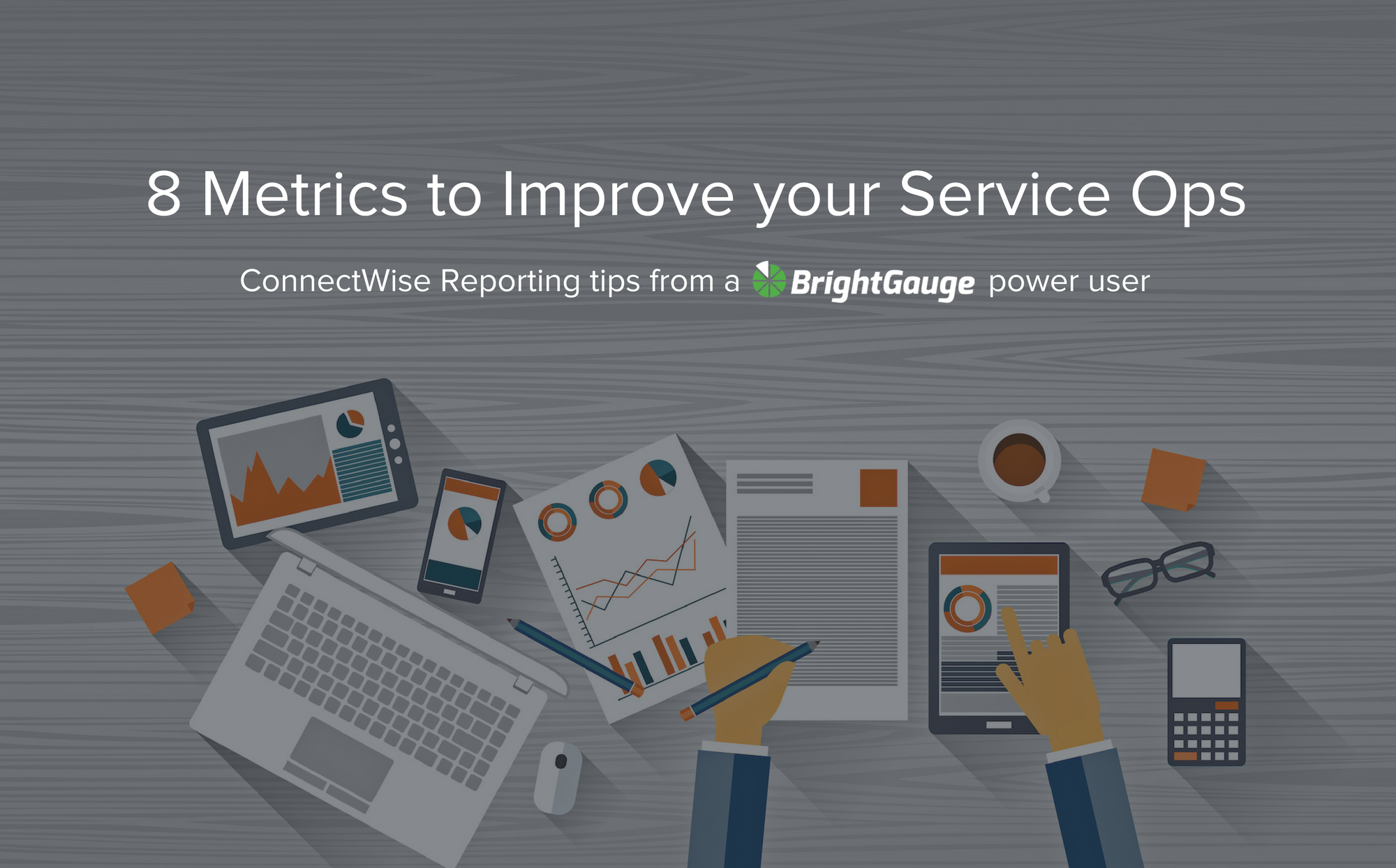
When it comes to the questions our customers ask us here at BrightGauge, there are a handful that are extremely popular. Two of those questions revolve around which metrics should I be monitoring, and what is everyone else tracking? So we asked Karl Fulljames, VP of Operations at Nucleus Networks, and BrightGauge power user, to shed some light on the gauges created from his ConnectWise data and used in internal reports. The Nucleus team is made up of about 45 staff, and they have offices spread across Canada in Victoria, Vancouver, Toronto, and Montreal. Karl is a long-time BrightGauge customer and often a beta tester as well. The gauges that you’ll see here were originally shared with the community during our Managing Productivity of a Service Team webinar, which is also available for you to download in its entirety. Let’s dive in for a closer look! Editor’s note: Because these gauges are from Karl’s internal data, some info has been blurred to conceal sensitive details. Using ConnectWise Data to Improve Service Ops 1. Incident Summary (Previous Month): This metric shows you the number of incidents per item, for one particular client and it indicates that something is broken. As Karl explains, note that there are 3 tickets in the Outlook category, and 4 tickets in the Mail category for a total of 7 (more than any other category). This suggests that there may be reason to dig in and see what's at the root of these tickets. Pro tip: The Nucleus team looks at this chart on a per-client basis per month, as well as across all of their clients, monthly, to see if there’s a trend, such as a bad patch that they didn’t detect, or an Office 365 issue, etc. Also, drilling down to per-client level is really useful for finding out what’s happening in that client’s environment. This part of the report generally stays fairly static, but some months there will be a jump and the Nucleus team is alerted that they need to dig into the details. Want to learn Karl’s reasoning behind these incident categories and how they were selected? Hear the entire discussion in the Managing Productivity of a Service Team webinar. 2. Incidents by Client Previous Month: Here you’ll see the number of incidents per client in the previous month… or as Karl puts it, which clients have the most things broken or burning. This gauge indicates which clients to do a root cause analysis on, so that you can figure out what’s actually causing those tickets to be created. Doing this analysis leads to future project revenue and also reduces overall support hours! Pro tip: If a client is putting in 51 tickets as you can see on the right side of the chart, then they probably have a lot of stuff broken. However, Karl cautions that the number of tickets is not actually the best indicator of what’s actually happening. That’s why you should also use... 3. Incident Hours by Client Previous Month: This metric will show you if the client who submitted the most tickets has issues that are fast and easy to solve, or it will highlight clients who have only a few tickets, but take a significant amount of time to fix. This is the better indication of what’s actually broken for each client! Karl explains that because the number of tickets does not indicate which client is busiest, you need to make sure that you’re checking a couple of different gauges to get a better idea of what’s actually going on. For example, the top client in the previous Incidents by Client gauge, with 51 tickets, didn’t even break the top 10 when viewing the data here. Pro tip: Each month the Nucleus team will focus on the top 5 busiest clients that they can reduce hours on, because they charge a fixed price per month, per client. As a result, it’s in their best interest to make problems go away, forever. In the first month Karl implemented this gauge, he realized that a mid-sized client had 60% of their hours going to supporting their FTP site, which wasn’t noted before because the Nucleus team has so many techs doing different types of work. Consolidating the data led to a much better solution which the client was happy to pay for because it resolved all of the support issues. 4. Config Items and Tickets Previous Month: By adding config items and tickets together, it’s very easy to see the number of hours spent on a certain piece of equipment in the previous month. This type of data drives down hours because you’ll easily notice what needs to be looked into. For example, Karl sees this data and realizes that a SQL server cost him nearly 17 hours last month. Perhaps it’s old and needs to be replaced, maybe there was a cryptovirus, or a bad backup - whatever the reason, he knows that they shouldn’t be spending anywhere close to this much time on it. However, with this data at hand, it’s easy to see what needs to be addressed, which gets rid of a headache for the client, but is also a huge win for Nucleus. By fixing the top 10-12 issues through a project, the team earns extra revenue, and the problems and hours spent fixing those issues go away. Pro tip: A use case scenario would be for clients whose users roam around from desk to desk, not on dedicated machines. By adding the config item to the ticket, you’ll know if the workstation is having an issue. Holding Your Service Team Accountable 5. Support Team Hours (chart): Shows you where each team member is spending their time, with a breakdown of project hours, support hours, internal work, and absent time. Karl sends this chart directly to each Tech... daily, weekly, and monthly. At Nucleus, every Tech should show 37.5 - 40 hours per week so in this case it’s easy to see who’s falling short, like the first person who has less than 20 hours for the week. This gauge makes it easy for Karl to see that it’s time to talk with this Tech so he can understand what’s going on: are they burnt out, or need more work, perhaps they don’t like their job and want to quit. Pro tip: Another benefit of this gauge is the transparency and self-policing that it promotes. Because every person on the team can see what the others are working on, they keep each other in check and Karl doesn’t have to get involved unless a red flag comes up. It’s also helpful in employee reviews because sometimes people ask how they are doing in comparison to the rest of the team. 6. Support Team Hours (table): This is a second view to show you where each team member is spending their time, with a breakdown of project hours, support hours, internal work, and absent time. Editor’s note: this gauge requires BrightGauge’s Advanced Plan with Calculated Metrics Similar to the Support Team Hours Chart above, but in this case we’re looking at a different week. The color thresholds that Karl has chosen for this gauge indicate 37.5 or less hours (red), 37.5 - 42 hours (green), and over 42 hours (purple). Karl can easily see that Tech # 1 is short a whole day’s worth of hours, while Tech # 5 went over, so he knows that it may be time to re-assign work in a better way to keep hours more even. Pro tip: The last column, “chargeable” (different than billable/support hours for the Nucleus team) indicates billing on projects, so Karl can see how much of a person’s time is being spent on project time. The numbers are based on each Tech’s timesheet they are submitting, so there’s no argument on where they stand. Managing Service Team Productivity 7. Technician Utilization Yesterday: Measures how much of each Tech’s day is spent on billable time (profit!) At Nucleus, this gauge is also live on a dashboard, but the entire team receives the previous day’s recap each morning. Monitoring Tech Utilization is another way to show which teammates need to have their work balanced for those who are well below or well above the average rate, assuming 100% utilization. Karl notes that the most important part of tracking Tech Utilization is being able to talk to the team immediately about their hours. If you wait 2 days to talk to a Tech, they may not remember... so instead, talk to them while it’s happening. Pro tip: Keeping a live view of this metric is critical because if you fall even one day behind on updating it, you can’t catch up. 8. Effective Rate: This metric is a calculation made by taking revenue from managed services agreement and dividing by the number of hours. Editor’s note: this gauge requires BrightGauge’s Advanced Plan with Calculated Metrics This is Karl’s simple version of effective rate, although he also has a more advanced version. Using this version of the calculation, if a client pays $2,000 and they use 10 hours, your Effective Rate would be $200/hour. The Nucleus gauge tracks Effective Rate by previous month, previous 3 months, and previous 12 months, and obviously the more hours spent on a client, the more the Effective Rate goes down. Karl notes that there are many ways of making this calculation, including the ConnectWise version and the BrightGauge version. Shameless plug: he also confirms that the BrightGauge version is the way to go, after getting schooled on a bit of algebra from our very own teammate, Randall. Trends are especially important to note when it comes to Effective Rate. If you have a client with a really good Effective Rate and it’s increasing over time, then you’ll want to do more of whatever it is you’re doing. If you have a client whose Effective Rate is declining over time, it’s a huge indicator that you need to get in front of whatever is going on. Did they add a bunch of people, and you didn’t realize it? Did they change their business strategy? Whatever the reason, the point is that they’re creating more tickets and costing more hours. Pro tip: The questions you want to ask yourself are: What are your effective rates? What is your break even? What is the goal you're aiming for? Next steps for internal reporting With 8 awesome new gauges to be made from your ConnectWise data, are you ready to learn more? Karl shares 7 additional gauges, plus his resolve and close procedure, top metrics used by the Nucleus team, and tons of other insights in Managing Productivity of a Service Team, an on-demand webinar.
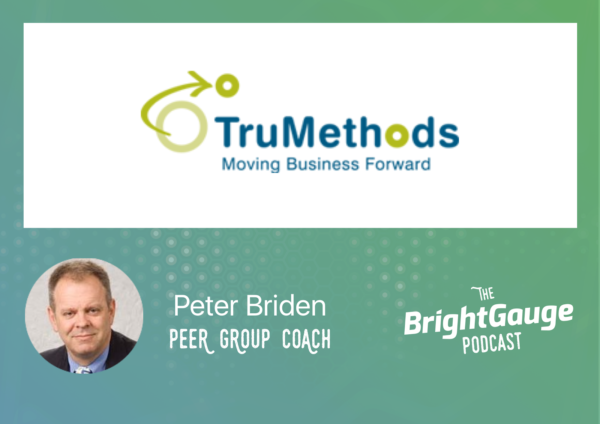
Customer Success is all about ensuring that customers achieve their desired outcome in the world of B2B products. It’s not a new term, but outside of the SaaS world, Customer Success doesn’t always garner the same buzz. That’s where Peter Briden, MSP Peer Group Coach, comes in. After studying Customer Success in depth, and finding common threads between it and success patterns from his days as an MSP owner, Peter is spreading the word about how Customer Success applies to our industry. Join us for the full conversation... Customer Success in Managed Services: Episode Highlights Peter’s intro and background (0:52) The Millionaire Next Door philosophy, and how it helped Peter change gears to work on business goals (2:54) What’s the one thing you miss, and one thing you don’t miss, about being an MSP? (7:26) What is Customer Success, and why do you advocate for it? (9:30) In the business of recurring revenue, MSPs shouldn’t lose sight of the customer’s lifetime value while focusing on initial sales (14:59) The two types of loyalty: attitudinal and behavioral (19:13) How to deliver Customer Success (24:51) The Strategic Coach: 4 Habits of Referability (30:03) How MSPs can get started with Customer Success (32:31) Attributes to help identify an ideal customer (35:12) Reach out to Peter to get the free TruMethods tools + his favorite Customer Success Resources (39:15) One last tip about the back office role in Customer Success (39:54) Common challenges Peter sees from MSPs navigating the industry (43:09) Q&A: favorite books and how to connect with Peter (48:15) Books referenced in the episode: Great by Choice: Uncertainty, Chaos, and Luck - Why Some Thrive Despite Them All, by Jim Collins The Phoenix Project: A Novel about IT, DevOps, and Helping Your Business Win, by Gene Kim, Kevin Behr, and George Spafford Want to find out more about The BrightGauge Podcast? Check out all the episodes here.
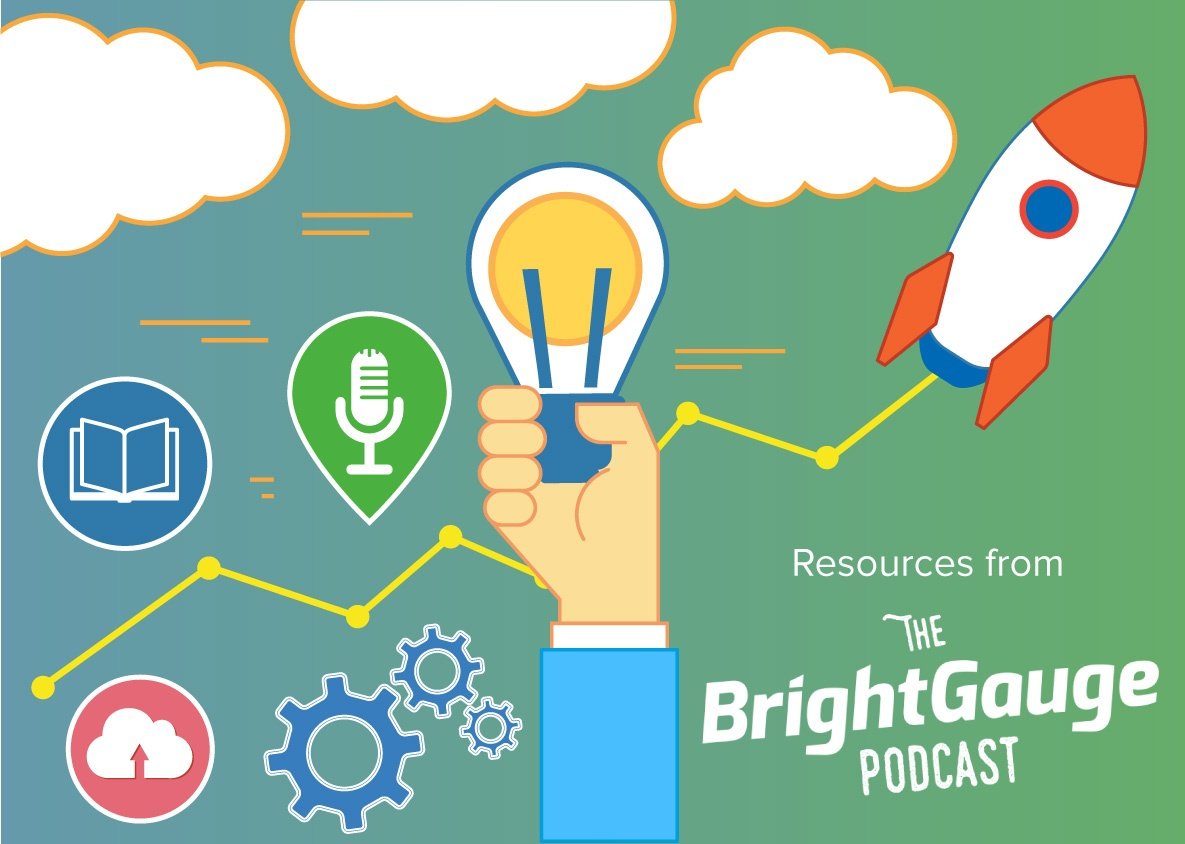
Back in the early days of The BrightGauge Podcast, we decided that we would ask our guests to recommend their favorite resources for advancing their business, or for self improvement. Now with 38 episodes (and counting!) in the line-up, join us for a look back as we share all of the great books, softwares, blogs, podcasts, and other resources we’ve collected along the way: Editor’s note: Compiling this list proved challenging when it came to the best way to share it. While the original thought was to break down the list by episode, many of our guests referenced the same resources, especially when it came to books. We’re instead sharing the list by resource type. First things first: make sure you're caught up on all the episodes of The BrightGauge Podcast! Besides the great resource recommendations, our guests offer a ton of insights about how to improve your MSP business with advice on topics such as finding and keeping the right employees, how to build a sales team, the key to focusing on the right data, specific KPIs you need to know, ways to improve your customer satisfaction scores, and so much more. Now, let's dive in and see what our guests have to say about their favorite learning materials... Book Recommendations: Anything You Want: 40 Lessons for a New Kind of Entrepreneur, by Derek Sivers Black Box Thinking, by Matthew Syed Circle of Safety, Simon Sinek Crossing the Chasm: Marketing and Selling High-Tech Products to Mainstream Customers, by Geoffrey Moore David Maister, Professional Services guru (series of books) Delivering Happiness: A Path to Profits, Passion, and Purpose, by Tony Hsieh Drive: The Surprising Truth about What Motivates Us, by Daniel Pink Driven: How to Succeed in Business and In Life, by Robert Herjavec EntreLeadership: 20 Years of Practical Business Wisdom from the Trenches, by Dave Ramsay Good to Great: Why Some Companies Make the Leap… And Others Don’t, by Jim Collins Great by Choice: Uncertainty, Chaos, and Luck - Why Some Thrive Despite Them All, by Jim Collins How to Win Friends and Influence People, by Dale Carnegie It’s Your Ship: Management Techniques from the Best Damn Ship in the Navy, by Captain D. Michael Abrashoff Leaders Eat Last: Why Some Teams Pull Together and Others Don’t, by Simon Sinek Leading on Purpose: Sage Advice and Practical Tools for Becoming the Complete Leader, by Timothy I. Thomas and Charles “Rip” Tilden Lure the Tiger Out of the Mountains, by Yuan Gao Malcolm Gladwell (any of his books) Mastering the Rockefeller Habits: What You Must Do to Increase the Value of Your Growing Firm, by Verne Harnish Now, Discover Your Strengths, by Marcus Buckingham and Donald O. Clifton Predictable Revenue, by Aaron Ross Profit First: Transform Your Business from a Cash-Eating Monster to a Money-Making Machine, by Mike Michalowicz Raising the Bar: Integrity and Passion in Life and Business (The Story of Clif Bar Inc.), by Gary Erickson Scaling Up, by Verne Harnish Scaling Up Excellence, by Robert Sutton & Huggy Rao Shoe Dog: A Memoir by the Creator of Nike, by Phil Knight Spin Selling, by Neil Rackham The Advantage: Why Organizational Health Trumps Everything Else in Business, by Patrick Lencioni The Art of War, by Sun Tzu (note there are several different translations available) The Big Five For Life Continued, by John Strelecky The Breakthrough Company, by Keith R. McFarland The E-myth Revisited: Why Most Small Businesses Don’t Work and What To Do About It, by Michael Gerber The Effective Executive: The Definitive Guide to Getting the Right Things Done, by Peter Drucker The Go-Giver: A Little Story About a Powerful Business Idea by Bob Burg and John David Mann The Joshua Principle, by Tony Hughes The Lean Startup: How Today’s Entrepreneurs Use Continuous Innovation to Create Radically Successful Businesses, by Eric Ries The Millionaire Next Door: The Surprising Secrets of America’s Wealthy, by Thomas J. Stanley The Miracle Morning: The Not-So-Obvious Secret Guaranteed to Transform Your Life (Before 8 AM), by Hal Elrod The Phoenix Project: A Novel about IT, DevOps, and Helping Your Team Win, by Gene Kim The 4 Hour Workweek, by Timothy Ferriss The 5 Dysfunctions of a Team: A Leadership Fable, by Patrick Lencioni The 80% Approach, by Dan Sullivan Traction: Get a Grip on Your Business, by Gino Wickman Turn the Ship Around, by L. David Marquet Walk Away Wealthy: The Entrepreneur’s Exit-Planning Playbook, by Mark Tepper Blogs You Need to Know: Krebs on Security Seth Godin Technology Marketing Toolkit Customer Thermometer’s CSAT blog ryangiles.com/library (reading list) Podcasts to Check Out: MSP Radio by Continuum Smart People Podcast The Tim Ferriss Show Radiolab Evolved Radio Revisionist History Software Solutions: CirrusInsight.com, saves emails to SalesForce Trello, project management app Zapier, integration connection tool Peer Groups for MSPs: TruMethods HTG Other Resources: TED talks The One-Page Plan (and other growth tools from Verne Harnish) RSA Conference Sans.org Now tell us, do you have a favorite book or other resource when it comes to business or personal development? Add your suggestions in the comments below:
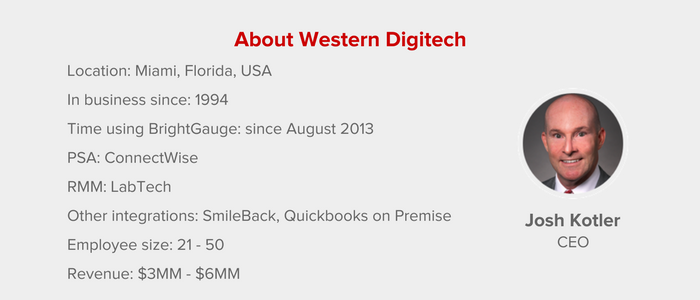
[Case Study] As the founder and CEO of Western Digitech, Josh Kotler was continually running into problems with reporting and data measurement. The lack of easy access to data was affecting their business processes, and using Excel spreadsheets to track efficiency among employees came with several pain points: Three Biggest Points of Frustration Pre-BrightGauge Their data was in a format that made it tough to share and consume. The team didn’t have the ability to benchmark performance visually, limiting their ability to respond to the issues the data highlighted. Because the data was harder to measure, Western Digitech measured less. Since they measured less, performance suffered. At the same time, proving the value of their work to clients was difficult without a reliable way to extract and organize that data. Josh explains, “we wanted to be able to send our clients attractive and meaningful reports that demonstrated how much we were accomplishing on their behalf.” Aware of these issues within his business, Josh was actively seeking a solution when he first discovered BrightGauge at the IT Nation conference. Shortly after seeing BrightGauge in action, he learned that a friend’s MSP was also using the platform. This prompted his decision to move forward, along with BrightGauge’s reputation within the industry: Adopting BrightGauge After a short walk-through of the features with the BrightGauge team, Western Digitech was up and running. Josh goes on to say that while the implementation process was incredibly easy for his team, he was more impressed with how intuitive the platform is: One early benefit that the company noticed was the ease with which BrightGauge was able to improve their business processes and culture, such as their “better every quarter” mentality. Josh went on to explain how much he likes the insights that BrightGauge provides to each manager, allowing them to build out their own dashboards with the data that is most relevant to their position. Results with BrightGauge Western Digitech quickly noticed several benefits following their BrightGauge implementation, beginning with the ability to access data in real-time. Instead of examining reports from previous days and weeks, their team is now able to identify issues, analyze operations, and deploy solutions much more quickly. “We can build a better business with less frustration and effort,” Josh explained. Then, there’s the progress in sales and service delivery due to the real-time insights that are now so easy to come by. In days past, the team wouldn’t have been able to keep up with the increased demand for their services while using traditional reporting. And the results? As Josh explains, Western Digitech has seen a huge jump in profitability: Josh also pointed out that the addition of dashboards in Western Digitech’s helpdesk area has created a friendly sense of competition, especially when it comes to their number of completed tickets. “As guys chase numbers, response times have improved. Also, our Team Leaders have better data - timely data - and can better manage based on that data.” As with any software solution, the benefits of the product itself are only part of the picture, because the support that comes with it can make or break the user’s experience. “The support from the BrightGauge team has been exemplary. They are into data visualization and they’re excited to learn about new applications and gauge ideas. If you can dream it, they can make it a reality,” Josh says. Recommending BrightGauge For the Western Digitech team, finding a tool that was user-friendly and ready to go from day one was critical: Josh sums up his BrightGauge experience, saying “you can’t improve what you don’t measure. If you are serious about raising your game, you must understand your KPIs - BrightGauge makes that easy!”

70+ Metrics for MSPs
Key metrics and accompanying formulas to help MSPs skyrocket growth and success!
Get your KPIs

Have you been in managed services long enough to realize just how critical it is to revamp your operational strategies in order meet your snowballing list of obligations? If so, then you’ve probably also noticed that a willingness to adapt is critical in order to sustain that growth. Luckily, there are a few key areas that any MSP can focus on to improve their operational efficiency. First, remote management and the rise of cloud solutions provide a critical tool for the future of forward-thinking MSPs. Additionally, being able to boil down your services into concrete, defined service offerings opens the doors to processes that help to improve your ability to deliver. Let’s take a look at the key areas that you should be focusing on to improve operational efficiency: Maximizing Remote Management & Automation For many years MSPs primarily worked on a break/fix model. Something in the tech chain broke, and MSPs were there to fix the problem. However, the rise in popularity of remote management and cloud-based services have changed the way that MSPs interact with clients. It has opened the doors to low-hanging opportunities for operational efficiency improvements. Remotely managing a large volume of a customer's infrastructure compels the use of automation. Once you identify the processes that can be automated and implement the right tools, you will free up man hours and improve your services at a big-picture level. That means less time in the trenches, more time focusing on delivering value. In fact, MSPs should be excited to find new ways to automate their services. Because while other business models rely on billable break/fix hours to drive revenue, MSPs are able to earn more while doing less by maximizing remote management and the automation of business processes. Processes and Uniformity The idea that every customer is unique and needs a unique solution is a popular marketing statement among MSPs. It’s true, too. Every client will come with their own unique quirks that will have to be accounted for. What that marketing messaging doesn’t say is that for most clients, the core of your services won’t look any different from one client to another. In a recent conversation with Ray Orsini, Owner of Orsini IT, we discussed the important role that standardization plays in his business. Because they offer every client the same service at the same price, with very little wiggle room for customization, they have eliminated the need to spend their time rewriting contracts each time they bring a new account on board. By standardizing their SLA across the board and setting very clear expectations up front, the Orsini team can keep their focus on the services they provide. Of course, staying focused on their services yields a very efficient operation. Eliminating gray areas allows MSPs to make focused hirings, keeping their teams small and their response times low. Spelling out every service in your SLAs gives you the opportunity to move forward with new clients confidently. Of course, there is a caveat to this. Not all customers are going to be receptive to a standardized service. In our conversation, Ray went on to explain that in order to commit to standardization, you must be willing to tell certain prospects that you aren’t a good fit for their needs. When they start making requests and trying to alter your core offering to fit their needs, it may be time to move on. This may feel like leaving money on the table, but ultimately it makes your operations scalable. “Managed services is like a marriage — we have to respect each other,” Ray said. Dashboards, Analytics, & Managing By Exception Have you heard of Inbox Zero - the practice of getting your inbox down to zero unread messages? At BrightGauge, we encourage a similar approach in business. We advocate for all of our MSP customers to practice “managing by exception,” which is an extremely effective practice when paired with standardized services. Using your BrightGauge dashboard to manage by exception involves two basic rules: No red. Using the BrightGauge color and threshold features, you can assign colors to certain benchmarks. In the above example, there is one new ticket open. This is an issue because you never want a ticket to go unanswered. Using the color and threshold features, it is easy to identify problems and keep on top of the most pressing matters. Get to zero. Whittle down your numbers throughout the day with the goal of getting to zero in all relevant categories. Do you notice how the “Open Billing” section in the image above is green? That’s because there are no open billing matters to attend to, turning the number green. Ideally, you want the entire top row to show green by the end of each day. Dashboards Maximize Efficiency For MSP owners, your ability to standardize your services, automate your processes, and quickly track and address changes in key metrics play a huge role in your long-term growth potential. By focusing on these key areas, you can improve hiring practices and reduce response times for each and every client. Want to learn more about operating efficiently? Download our free whitepaper on Dashboard Best Practices:

“How often are you meeting with your team?” was the burning, top-of-the-list question during our journey to understand the best practices behind growing an MSP sales team. We sat down with Nate Austin, VP of Business Development at Mytech Partners, to gain some first-hand knowledge on the matter. Since 2000, Mytech has grown from an idea into an MSP with 3 offices and 90 employees spread across Minnesota and Colorado, and the leadership team picked up a lot of tips along the way. As we learned from Nate, your one-on-one meetings should be weekly, but there are two different kinds of one-on-one meetings you should have: deal strategizing and coaching - which is popular among business owners - but owners often lose sight of the second one, which should focus on accountability. Join us for a conversation all about MSP sales teams: the qualities to look for in a good salesperson, how to train them, onboarding advice, KPIs you need to know, and more! How to Build an MSP Sales Team + the KPIs You Need to Know: Episode Highlights Nate’s intro and background (0:50) A typical day as VP of Business Development (4:44) The demographics of the Mytech Partners team (6:56) Leveraging multiple help desk teams (10:02) How do you package and price your managed services offerings? (15:20) The qualities of a good salesperson in the managed services business (18:15) How do you train salespeople to identify a business need and match to a solution? (21:24) Nate’s onboarding advice to make sure salespeople are successful (24:14) A closer look at Mytech’s Sales Team meetings (27:34) KPIs and tracking performance for the Mytech Sales Team (30:29) High level steps in the sales process (38:45) Q&A: Best business book, favorite resource for personal development, parting advice for MSPs, how to reach Nate (44:32) Book mentioned in the episode: Leaders Eat Last: Why Some Teams Pull Together and Others Don’t, by Simon Sinek Want to find out more about The BrightGauge Podcast? Check out all the episodes here.

Have you found that your margins tend to erode the longer that you stay with a client? It’s a common issue that many MSPs face. Over time, as client’s needs change, the services rendered change as well. Often, this doesn’t come with a renegotiation of the managed service agreement in full, but rather a small amendment. As your services change, so too do your margins. Historically, many MSPs employed a model of remote management and monitoring. They supplied and managed a range of hardware solutions for their clients. They also often sold new hardware to a client as part of an initial infrastructure upgrade during the onboarding process. Now, as more clients shift toward cloud-delivered solutions, MSPs must find new revenue streams to replace old ones. These issues combined with lowering your prices to compete can be a deadly combination. Competing solely on price overlooks the areas of your business that you have put blood, sweat, and tears into developing. Those areas should be the selling points that differentiate your company from your competition. Valuing your services appropriately entails a lot more than simply comparing prices with a competitor. As any MSP owner knows — there is a lot more that goes into delivering a top-notch managed service than most would assume. Let’s take a look at some of the strategies that MSPs can employ to avoid competing solely on price. Niche Your Company as a Vertical Specialist Want to attract the kind of clients that understand your value and are willing to pay top dollar for an exceptional service? MSPs can charge more by specializing in a particular vertical. Healthcare, retail, law, or other professional services are all popular verticals. Not only does this position your company as the ideal solution to companies in that industry, it allows you to focus on the specific skill sets that will resonate with those prospects. For instance, offering managed services to companies within the healthcare industry comes with its own set of considerations to maintain and facilitate HIPAA compliance. The same is true for servicing law firms. Niching your company as a specialist within a particular vertical may feel like you are pigeon-holing your business and scaring away clients outside of your chosen vertical. In truth, you’ll rarely find that specializing makes generalist clients apprehensive but goes a long way toward attracting clients within that industry. You put yourself in a position to compete on expertise, rather than on price. Target Specific Software Solutions or Vendor Programs Another excellent way to stand-out by niching down is to specialize in specific software solutions or vendor programs. In some cases, this software might only be present in a particular vertical. By marketing your MSP as specializing in a specific software solution, you make it easy to stand out against the backdrop of generalists. Prospects will immediately see that you are a good fit for their business. By building a verifiable track record in specific software stacks, you have proof to back it up as well. As time goes on, your familiarity with specific software solutions will genuinely make your company a more effective choice than the competition. Facilitating these skills and areas of expertise among your teams allows you to compete not on price, but on expertise and real business benefits. Use Real-World Examples to Highlight Service Divides with Competitors When negotiating with prospects, placing too much focus on price can be detrimental. Yes, nearly every client that you speak with will be concerned with the price of your services on some level. But, delving into your price compared to that of your competitors without looking at the reason for those differences is a recipe for margin erosion. You have likely seen competitors lower their prices over time to stay competitive, and it can be tempting to follow that same path. Instead, focus on the differences in service quality and coverage when discussing the differences in price between you and competitors. What do you bring to the table that makes your service worth more? Do you have stats, case studies, or analytics to back it up? Often, you may find that the examples that connect with prospects might be a bit outside the norm. In a recent conversation with Josh Kotler, CEO of Western Digitech, and long-time BrightGauge customer, we discussed this exact topic: “It’s not about price, it’s about the results you deliver,” Josh said. He then went on to give an example that he uses to drive home this point with new prospects. Let’s assume that the average system takes 6 minutes to boot up and login every morning. Generally, employees will go grab a cup of coffee and engage in some water cooler chat while waiting. In total, it might be as much as 15 minutes or more until they are at their desk and ready to start. That’s 15 minutes of time lost. A smart MSP might notice these inefficiencies, point out that their changes would have the system ready to go in just two or three minutes, and point to the boost in productivity for every employee in the company — a measurable improvement. Process is the Differentiator Ultimately, end users don’t leave their MSP because they are running into technical problems or take issue with the price points. Those are just a symptom of the real problem — a lack of business results to justify the investment. They aren’t upset that their user ran into a technical issue. They are upset because of the extended period of downtime that they incurred as a result of that problem. In that same conversation with Josh, he broke it down plainly. “Everything we’re doing is about risk and efficiency,” Josh said. He elaborated further, saying that the priority is always to get the end user back on track and working again. He mentioned how this was especially true for companies like law firms, who bill by-the-minute. For them, fast-fixes are crucial to resuming business and maximizing revenue. It all comes back to process. Not only the processes that you use to quickly resolve tickets but the process of identifying the root problem that caused the issue so that it can be addressed after the ticket is closed. Those processes ensure that you can avoid similar tickets in the future and provide measurable business impact to your clients. Position the Solution, Not the Ingredients Most MSP clients don’t care how something is done as much as the result that it achieves. That means that in the case of an average client, don’t focus on selling the cutting-edge tools and software that you use — sell the benefits that the software creates for your clients. (The exception to this being niche markets who know of the specific softwares for their industry.) Sell business results and peace of mind, not the technology that drives it. Having access to new and innovative technologies is great, but only if they facilitate your company providing better results than your competition, which should be the focus of any negotiation. Moving Forward As clients begin to shift toward cloud-based solutions, it is important that MSPs are able to diversify their revenue streams and position themselves to charge higher prices. To do that, you have to place less focus on price and more focus on the business outcomes. Do you have a success story to share about focusing on business outcomes instead of price when it comes to selling your MSP services? Tell us in the comments below.
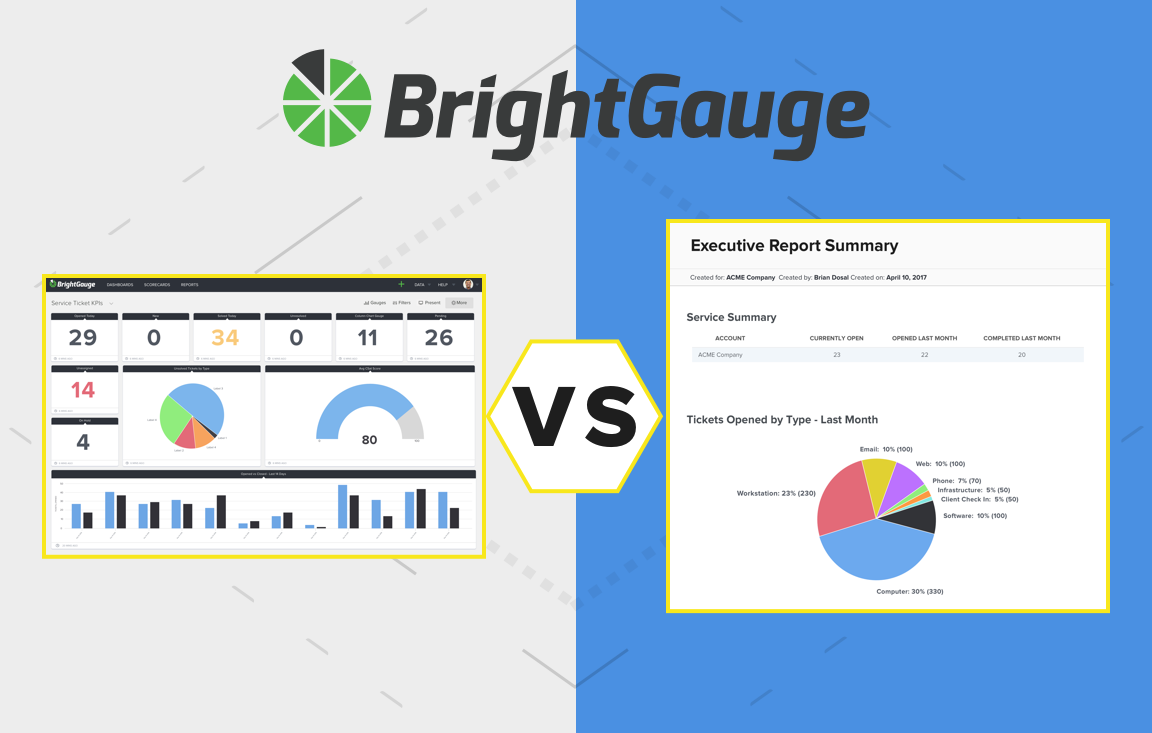
While dashboards and reports often feature the same information, the way in which they are used can actually be quite different. It’s a topic that comes up from time to time within our community, as users try to figure out which option is their best bet. To help you decide, we’ve put together our best tips based on different scenarios. In short, the best way to decide between a dashboard and a report (learn more about choosing dashboards vs. scorecards here) is to decide what you’re trying to achieve. Let’s take a closer look: The Best Use for Dashboards At BrightGauge, we always say that dashboards are the cornerstone for providing a complete picture of the health of your company. Because dashboards are extremely customizable, you also have control over what data points you show, and they’re flexible when it comes to your decision on whether you provide daily, weekly, or monthly insights. Dashboards have quite a few benefits that you'll notice when using them: Real-Time & Right Now BrightGauge dashboards allow business owners to select their most urgent KPIs for monitoring, which means that you always know what needs your attention, in real-time. That means no more looking back on your performance in a P&L at the end of the month, wondering what went wrong. Keep your team in sync Another benefit of choosing to display information through dashboards is that you can ensure that your entire team is on the same page. When each team member has job-relevant data on a heads-up display (HUD), all they have to do is glance up to see how their team is trending in real time. A great example of this would be displaying customer satisfaction (CSAT) data on a dashboard for your Service team to monitor throughout the day. Sleek addition to your office decor One of the most popular use cases we hear from BrightGauge customers is that they love to display their dashboards on the wall where they are easily seen during site visits by their prospects. Not only do they look great, but it also shows your potential new customers that you have a handle on your business and your team! Our friends at Nucleus Networks share their beautiful office + dashboard view Increases transparency Employees love to know the inner workings of the company that employs them. Dashboards are a great way to provide transparency to your teams. Allowing your teams to plainly see the advanced KPIs provides insight and gives them the opportunity to better understand the reasons behind business decisions. Drives efficiency Efficiency is critical for the success of any business, but it’s especially a hot topic for any service-focused roles. Often, individual performances play a measurable role in the success of any team and dashboards help because they provide a complete top-down picture of both what is working and what isn't. With this information easily accessible, it’s also helpful to management for addressing which points need to be improved and when. Saves time Traditionally, business owners would have to log into multiple platforms to check their metrics, or ask an analyst to put together a report, both of which can take a significant amount of time. BrightGauge dashboards provide you with a complete picture without the hassle of having to hunt down the data. When all of your KPIs are in one spot, you can use your precious time for other things! The Best Use for Reports In some situations, a report might be the right choice over the dashboard view. Reporting makes it easy to examine trends and show clients the value of the services you provide, plus they also help to address any questions your customer may have - often before they arise. You'll see these benefits when using reports: View a Point in Time While dashboards are perfect for reviewing up-to-the-minute data, reports are ideal for looking at data from a specific time. As an example, if you wanted to export specific data points from your accounting and RMM softwares from a year ago, a report would be a faster, simpler option for generating that data. Push the Information BrightGauge reports are a great way to share information because you set them up once with all of the data points you want to send, and then schedule the regular intervals at which they will be delivered. Need to send your client a weekly recap of your work? Put together your report, schedule the day and time it should be sent to their email, and you never have to touch it again unless you want to make changes to the report. Want to share your KPI progress with your leadership team? Again, set your report up once and your team will have a full update delivered right to their inbox. Great for historical & trending data Reports are perfect for historical and trending data. While dashboards are the best option for real-time overviews, reports allow you to examine specific timeframes with ease. This makes reports an excellent choice for tax season, or for getting an idea of trends within your company or market. Increases Transparency While dashboards are the best bet for offering transparency to your team, the tables turn when you want to keep your clients informed. For clients, reports are a great way to ensure that you always have concrete proof of how valuable your work is. In a managed service business for example, reports are a great way to show clients that SLAs are being met. Drives Efficiency Like our dashboards, reports can also be a great way to examine efficiency and find ways to improve. For instance, if you wanted to show your customer service team that their response times had slipped in recent months, pulling historical CSAT data into a report is the simplest way to do so. When employees can see this data in front of them, they will be more likely to self-correct and examine their own efforts. Saves Time Reports are huge time-savers because once you create and save one, you never have to touch it again unless you want to make changes. If you’ve ever had to spend hours of your time pulling data from multiple sources, crunching the numbers, adding them to a spreadsheet, and maybe even trying to create charts out of that data, then you know that process is a headache waiting to happen. Reclaim hours of your time, and skip the pain relievers with an automated report that will do all the work for you! Next Steps for Mastering Dashboards or Reports There are reasons why both dashboards and reports are excellent features for our customers. Dashboards are the best tool for keeping tabs on your day-to-day business metrics, while reports are excellent for examining historical and trending data. Both give users the ability to customize their output and automate their updates as often as needed. Ready to learn more? Download our webinar recordings: Dashboard Best Practices and Client Reporting Best Practices.

Referrals are the most valuable types of leads for any business. A recommendation from a trusted source is a vote of confidence for your company. Referral leads come to you with a certain level of trust built-in, but learning how to ask for referrals can be difficult for business owners. If you don’t have a referral program in place, the best step that you can take is to ask your current clients if they know anyone that might be interested in your services. It can be a bit nerve-racking the first time that you ask. After all, you don’t want to put your clients in an uncomfortable situation. This is a common fear but is often an unfounded one. Remember that when you provide a great service, your clients will often be happy to recommend you to trusted friends. They will also see the recommendation as a way to build trust and further business relationships with the referred party. If you would like to attract more referrals from existing clients, here is a step-by-step process for starting the conversation. Step 1: Remind the customer of the benefits you provide Asking for a referral isn’t a big deal when you do great work that your clients love. Sometimes they may need a bit of a nudge to remember exactly how much value you provide to their business. By encouraging them to think about the value you bring to the table, you can push them to consider other business owners that might be interested in the same. Partnerships that provide a valuable return for them may also be valuable assets to their business connections. Step 2: Describe your ideal customer Every business owner knows what a nightmare it can be to take on the wrong client. It's always best to focus your efforts on a client that would be an ideal fit. Making the industries or types of companies that you work with clear can prevent a lot of headaches down the road. Additionally, you want to point your clients in the right direction as they consider possible referrals. Let them know exactly what type of businesses you are interested in working with and see if they know anyone that might fit the bill. Mentioning your ideal client can jump-start brainstorming that leads to a recommendation they would have otherwise overlooked. Step 3: Identify a benefit for the referral People are a lot more likely to help out a friend when it is mutually beneficial. Consider ways to provide value in exchange for a referral. You could offer them a small discount, provide some services for free, or even send them a finder’s fee for helping you to secure a new account. You don’t have to go overboard, but providing a small return in exchange for a referral can make it that much more worthwhile for current clients. Remember that some clients will see benefits in simply making the recommendation. Helping other companies improves relationships and strengthens bonds. Drive home how valuable the referral process is for all parties involved. Step 4: Suggest someone they already know Managed service providers often have a lot of insight into their client’s businesses. You may be aware of a few different companies that they work with, or have insight into their broader business relationships. If you know that they have a connection to a company that your services would benefit, there is nothing wrong with making the suggestion. Be active in the companies that you target for referrals. After all, your client may never think to recommend you to a friend on their own. Step 5: Ask for an introduction Once you’ve identified that they know someone who might be a good fit, be forward. Ask for an introduction. Nine times out of ten, your client will be happy to, at the very least, introduce you or outright recommend your service. You've spent a lot of time building a positive relationship with your clients. It would be silly not to leverage those relationships for more business. An introduction in itself is valuable even if it doesn’t result in the sale, as it creates familiarity and could lead to a sale down the road. Don't skip the follow through! Although it seems like common sense, make sure that you follow through. Call the referral when you say you will. Promptly provide any benefits that you offered in exchange for the referral. Put together proposals in a timely fashion. With the built-in trust that you have from your referral, displaying reliability, professionalism and follow-through can go a long way toward sealing a new contract. There is no quote that shows the importance of asking for referrals more than this one: “91% will give referrals if asked. Only 11% will ask.” - Dale Carnegie Want to learn more about how to identify your ideal customer? Download our webinar, featuring MSP Coach Richard Tubb:

We’re excited to welcome Sean Herman to our team as Web Developer! Here’s what you should know about the latest member of the growing BrightGauge crew: The Early Days Sean grew up in Allentown, Pennsylvania, probably made most famous by Billy Joel’s hit song. If that rings a bell, then Sean is quick to point out that the song is actually written about neighboring city, Bethlehem. We could get lost in the reasoning behind that, so let’s continue with Sean’s story… After studying English Literature at Lehigh University, Sean spent about 7 years doing research at FactSet Research Systems, a financial software company. When the time came for his next adventure, he set his sights on Cornell Tech in New York City, a new campus focused on software engineering and tied to the famed Cornell University. After earning his Masters in Information Systems, Sean and his family made the move to Miami so that they could be closer to relatives and also expand into larger living quarters than what NYC offers. He spent a year working in Django and Python software development at Showroom Logic, a digital marketing company for automotive dealerships. Although the company is local, the engineers all work remotely, so while his dachshund made a solid attempt at a collaborative work environment, Sean missed the team element. It was time to consider other options. Teaming up with BrightGauge We always ask our new teammates about why they decided to join us, and what they most look forward to accomplishing here. As Sean puts it, he was sold from the beginning on the fact that our company culture is such a priority, to everyone from our Leadership team down to our crew’s freshest faces. Sure, we do a lot of awesome activities together, but Sean points out that our focus on building a work community is also equally important: we strive to keep every day here fun and also emphasize being supportive and cooperative (our Core Values are Humble, Passionate, and Good). In addition to our great culture, Sean is ready to dive in to his development work! He explains, “With BrightGauge growing so quickly, and serving so many customers, scaling becomes a big challenge. I’ve worked on similar products before, but this is an exciting opportunity to work on some of those big performance and reliability problems that come with success.” After Hours When he’s not helping us build BrightGauge, Sean enjoys spending time with his lovely family: his wife Mary, and his son Jay. He also tries to devote some time to reading science fiction and history works, as well as volunteer his time for web development opportunities. Most recently, Sean completed a big volunteer project for a health tech app as part of the Clinton Health Access Initiative. Join us in welcoming Sean to Team BrightGauge!












